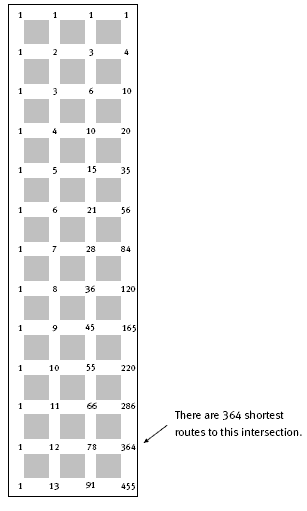This is a level 4 algebra strand activity from the Figure It Out series.
A PDF of the student activity is included.
Click on the image to enlarge it. Click again to close. Download PDF (260 KB)
use diagrams to describe a pattern
a copy of the map of the garden
square grid paper
FIO, Level 4, Algebra, Book Two, Up the Garden Path, page 9
Activity One
In this activity, students systematically explore the different shortest routes through a garden designed in the shape of a grid.
This garden grid with 9 flower beds shows the number of shortest routes to each intersection as well as the 3 shortest paths to the intersection A.
The students will need a large copy of the grid so that they can trace enough of the shortest routes to be able to see number patterns on their grid.
For some students, the number patterns may be more obvious when the grid is rotated a quarter-turn to the right. Then the numbers appear as in the table below, often referred to as Pascal’s triangle. The triangle of numbers can be extended indefinitely.
Blaise Pascal (1623–1662) was a French mathematician who, together with another French mathematician, Pierre de Fermat (1601–1665), created much of what we know as probability theory.
The relationship within each set of 3 numbers, such as those shown below, can be used to extend Pascal’s triangle to get the eighth row of numbers, the ninth row, and so on.
The students will need to use this pattern to figure out the answers to question 2 in the activity.
Activity Two
This activity asks students to design gardens on the basis of a given number of shortest routes. One way to design a garden with 28 shortest routes for question 1 is to arrange the flower beds in a rectangular array, that is, to reverse the thinking used in Activity One. In doing this, the students are effectively extending the numbers in Pascal’s triangle until they find the number 28.
The diagrams in the Answers show two possible flower bed arrangements with exactly 28 shortest routes through the flower beds. One garden shows a 6 by 2 rectangular arrangement of flower beds and the other shows a 2 by 6 rectangular arrangement.
The only other rectangular arrays of beds that have exactly 28 shortest routes are a single row of 27 beds or a single column of 27 beds.
Aisha’s garden can be extended, using Pascal’s triangle, to a garden that has at least 365 shortest routes, one for each day of the year. The students will need to use square grid paper to design this garden.
The garden shown in the Answers has 6 rows of 5 or a total of 30 flower beds, which is the smallest number of flower beds that a garden with at least 365 different shortest routes can have. In fact, there are 462 shortest routes altogether. This garden could obviously also be rotated through 90 degrees to give an arrangement with 5 rows of 6 beds.
The students might explore further to see if they can find the next smallest garden that has at least 365 shortest routes. The garden below has 36 flower beds and 455 shortest routes. Unless it is a leap year, Aisha will need to choose just one more route on the last day of the year when she has completed the 364 routes to the intersection marked below. (She will have 91 options for this last route.)
Answers to Activities
Activity One
1. a. The number of shortest routes to each intersection is shown on the map below.
b. i. The number of shortest routes to the lower right-hand corner of each flower bed is the sum of the number of shortest routes to the adjacent corners of the same flower bed. So, for the flower bed shown below (the last bed in the middle row), there are 4 + 6 = 10 shortest routes to the lower right-hand corner of the bed.
ii. In the example given for i, Aisha must either pass by the upper right-hand corner or the lower left-hand corner of the last flower bed in the middle column. There are 6 ways to get to the upper right-hand corner and 4 ways to get to the lower left-hand corner. So, altogether, there are 4 + 6 = 10 ways to get to the lower right-hand corner.
2. Aisha is correct. The pattern of numbers for the shortest routes to the intersections is shown below.
There are 70 different shortest routes from the entrance to the exit. Even if Aisha walked through the garden every day for 2 months, including weekends, the maximum number of routes needed would be 62 (2 months with 31 days).
Activity Two
1. Two possible arrangements of the flower beds are shown below.
2. Aisha works on a year as 365 days (a leap year has 366 days). So she needs a minimum of 30 flower beds (6 rows of 5 flower beds or 5 rows of 6 flower
beds). The number of shortest routes for this arrangement is 462.










